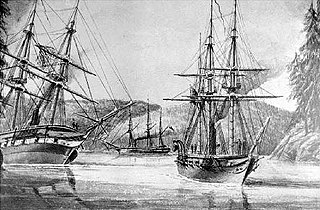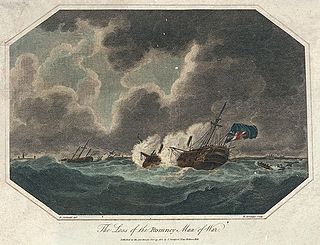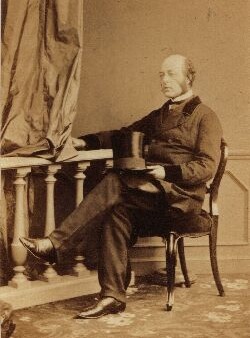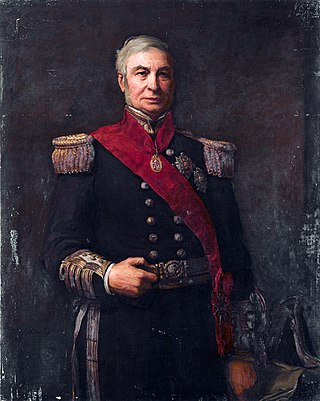
The first HMS Shah was a 19th-century unarmoured iron hulled, wooden sheathed frigate of Britain's Royal Navy designed by Sir Edward Reed. She was originally to be named HMS Blonde but was renamed following the visit of the Shah of Persia in 1873.

Admiral Sir Astley Cooper Key, was a Royal Navy officer. As a junior officer he saw action at the Battle of Vuelta de Obligado in November 1845 during the Anglo-French blockade of the Río de la Plata and took part at the Battle of Bomarsund in August 1854 and the Bombardment of Sveaborg in August 1855 during the Crimean War. He also went ashore with the naval brigade to take part in the Battle of Canton in December 1857 during the Second Opium War. He later commanded a specially-formed Baltic Fleet created in February 1878 to intimidate Russia from entering Constantinople during the closing stages of the Russo-Turkish War. He became First Naval Lord in August 1879 in which role he was primarily interested in administration and technology rather than strategy: he kept the cost of running the Navy within budgets, sanctioned the construction of six Admiral-class battleships and ensured the Navy was properly prepared for the Panjdeh Incident in 1885 when Russian forces seized Afghan territory at Panjdeh.
Admiral Sir William Fanshawe Martin, 4th Baronet,, was a Royal Navy officer. As a commander, he provided valuable support to British merchants at Callao in Peru in the early 1820s during the Peruvian War of Independence. He became First Naval Lord in the Second Derby–Disraeli ministry in March 1858 and in that capacity acted as a strong advocate for the procurement of Britain's first ironclad warship. He went on to be Commander-in-Chief, Mediterranean Fleet and in that role provided important assistance during the Italian disturbances in 1860 and 1861, reformed the system of discipline in his fleet and developed a comprehensive system of manoeuvres for steam ships.

Admiral Arthur William Acland Hood, 1st Baron Hood of Avalon, was an officer of the Royal Navy. As a junior officer he took part in the capture of Acre during the Oriental Crisis in 1840 and went ashore with the naval brigade at the defence of Eupatoria in November 1854 during the Crimean War. He became First Naval Lord in June 1885 and in that role was primarily concerned with enshrining into law the recommendations contained in a report on the disposition of the ships of the Royal Navy many of which were unarmoured and together incapable of meeting the combined threat from any two of the other naval powers : these recommendations were contained in the Naval Defence Act 1889.

HMS Plumper was part of the 1847 programme, she was ordered on the 25 of April as a steam schooner from Woolwich Dockyard with the name Pincher. However, the reference Ships of the Royal Navy, by J.J. College, (c) 2020 there is no entry that associates this name to this build. The vessel was reordered on August 12 as an 8-gun sloop as designed by John Fincham, Master Shipwright at Portsmouth. Launched in 1848, she served three commissions, firstly on the West Indies and North American Station, then on the West Africa Station and finally in the Pacific Station. It was during her last commission as a survey ship that she left her most enduring legacy; in charting the west coast of British Columbia she left her name and those of her ship's company scattered across the charts of the region. She paid off for the last time in 1861 and was finally sold for breaking up in 1865.

HMS Hydra was the lead ship of her class of wooden steam paddle sloops of the British Royal Navy, launched in 1838 at Chatham Dockyard. After taking part in operations during the Syrian War in 1840, she then served on anti-slavery operations and also as a survey vessel. She was scrapped in 1870.

HMS Inconstant was an unarmored, iron-hulled, screw frigate built for the Royal Navy in the late 1860s. Upon completion in 1869, she was the fastest warship in the world and was assigned to the Channel Squadron. Two years later the ship was transferred to the Detached Squadron for a brief time before she was paid off into reserve in 1872. Inconstant was recommissioned in 1880 for service with the Flying Squadron that circumnavigated the world in 1880–82. On the return voyage, the ship was diverted to Egypt during the Anglo-Egyptian War of 1882 and played a minor role supporting operations ashore. She was reduced to reserve again after her return and was served as an accommodation ship in 1897. Inconstant was hulked in 1904 and became a training ship in 1906. She continued in that role, under a variety of names, until she was sold for scrap in 1955 and subsequently broken up, the second-to-last surviving Pembroke-built warship in existence.

Admiral Sir Compton Edward Domvile, was a distinguished Royal Navy officer in the Edwardian and Victorian eras.

Admiral Sir George Greville Wellesley was a Royal Navy officer. As a junior officer he took part in the capture of Acre during the Oriental Crisis in 1840 and, as Captain of HMS Cornwallis in the Baltic Fleet, he took part in the Bombardment of Sveaborg in August 1855 during the Crimean War. He went on to be Commander-in-Chief of the North America and West Indies Station and then Commander-in-Chief of the Channel Squadron but was relieved of the latter post by a court-martial after an incident in which an armoured frigate, which had been under his command at the time, ran aground at Pearl Rock off Gibraltar in July 1871. He was appointed First Naval Lord in November 1877 and in that capacity he secured a considerable increase in naval construction, for example on the Colossus-class battleships, although some of these ships were of doubtful quality.

HMS Agincourt was a 74-gun third-rate ship of the line of the Royal Navy, launched on 19 March 1817 at Devonport.
HMS Highflyer was a 21-gun wooden screw frigate of the Royal Navy. She was built on the River Thames by C J Mare and launched on 13 August 1851. She spent twenty years in service, including action in the Crimean War and the Second Opium War, before being broken up at Portsmouth in May 1871.

HCS Bombay, later HMS Bombay and HMS Ceylon, was a teak-built fifth rate, 38-gun wooden warship built in the Bombay Dockyard for the Honourable East India Company (HEIC) and launched in 1793. The Royal Navy purchased her in 1805 and renamed her HMS Bombay. She served with the Royal Navy under that name until 1 July 1808, when she became HMS Ceylon. She was sold at Malta in 1857 and broken up in 1861.

Rear Admiral Sir Thomas Hounsom Butler Fellowes was an English officer in the Royal Navy during the Victorian era.

HMS Romney was a 50-gun fourth rate of the Royal Navy. She served during the American War of Independence, and the French Revolutionary and Napoleonic Wars in a career that spanned forty years. Five ships of the Royal Navy have been named HMS Romney. The origins of the name are from the town of New Romney, although it may be that the name entered the Royal Navy in honour of Henry Sydney, 1st Earl of Romney.
Admiral Sir Lawrence William Halsted GCB was an officer of the Royal Navy who served during the American War of Independence and the French Revolutionary and Napoleonic Wars.

HMS Niger was originally slated to be built as a Sampson designed sloop; however, she was ordered as a First-Class sloop with screw propulsion on 20 February 1845 to be built at Woolwich Dockyard, along the design developed by Oliver Lang and with a hull like the Basilisk designed paddle sloops. Her armament and engine were to be like the Encounter Design building at Pembroke. A second vessel (Florentia) was ordered on 26 March 1846 but after her keel was laid at Pembroke Dockyard, her construction was suspended on 6 October 1846 then cancelled three years later, on 22 May 1849. Niger She conducted important propulsion trials, finally proving the superiority of screw propulsion and served in West Africa, the Crimea, China, the East Indies and Australia. She took part in the New Zealand wars in 1860 and was sold for breaking in 1869.

HMS Eclipse was a four-gun Cormorant-class first-class gunvessel launched in 1860 from the shipyard of J. Scott Russell & Co., Millwall. She served on the Australia Station, took part in the Second Taranaki War, including contributing men to a naval brigade which attacked the Maori stronghold at Gate Pā. The entire class were never satisfactory as gunvessels, partly due to their excessive draught, and Eclipse was broken up at Sheerness in 1867, only seven years after her launch.

Admiral Sir Arthur Cumming was an officer of the Royal Navy.

Admiral of the Fleet Sir Alexander Milne, 1st Baronet,, was a Royal Navy officer. As a captain on the North America and West Indies Station he was employed capturing slave-traders and carrying out fishery protection duties. He served as a Junior Naval Lord under both Liberal and Conservative administrations and was put in charge of organising British and French transports during the Crimean War. He became Commander-in-Chief, North America and West Indies Station and in this role he acted with diplomacy, especially in response to the Trent Affair on 8 November 1861 during the American Civil War, when USS San Jacinto, commanded by Union Captain Charles Wilkes, intercepted the British mail packet RMS Trent and removed, as contraband of war, two Confederate diplomats, James Mason and John Slidell. He became First Naval Lord in the third Derby–Disraeli ministry in July 1866 and in this role took advantage of the Government's focus on spending reduction to ask fundamental questions about naval strategy. He again became First Naval Lord in the first Gladstone ministry in November 1872, remaining in office under the second Disraeli ministry and identifying the critical need for trade protection at times of war and demanding new cruisers to protect British merchant shipping.
Admiral Kenelm Somerville, 17th Lord Somerville was a Royal Navy officer and Scottish hereditary peer. He joined the navy in 1801 and served throughout the Napoleonic Wars, fighting at the invasion of Isle de France, Battle of Tamatave, and invasion of Java. He was promoted to commander in 1811 and in 1813 took command of the troopship HMS Thames which he sailed to North America to fight in the War of 1812. Promoted to post-captain in 1814, he commanded a flotilla in the expedition that burned Washington. Somerville retired from the navy in 1846 and continued to be promoted on the retired list, becoming an admiral in 1862. He inherited the title of Lord Somerville from his brother in 1842 and died at Newbold Comyn in 1864 at the age of 76.























